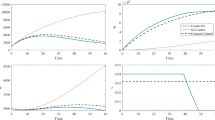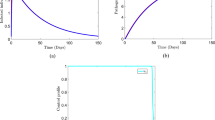Abstract
While cholera has been a recognized disease for two centuries, there is no strategy for its effective control. We formulate a mathematical model to include essential components such as a hyperinfectious, short-lived bacterial state, a separate class for mild human infections, and waning disease immunity. A new result quantifies contributions to the basic reproductive number from multiple infectious classes. Using optimal control theory, parameter sensitivity analysis, and numerical simulations, a cost-effective balance of multiple intervention methods is compared for two endemic populations. Results provide a framework for designing cost-effective strategies for diseases with multiple intervention methods.
Similar content being viewed by others
References
Blower, S.M., Dowlatabadi, H., 1994. Sensitivity and uncertainty analysis of complex models of disease transmission: an HIV model, as an example. Int. Stat. Rev. 2, 229–243.
Codeço, C.T., 2001. Endemic and epidemic dynamics of cholera: the role of the aquatic reservoir. BMC Infect. Dis. doi:10.1186/1471-2334-1-1.
Colwell, R.R., et al., 2003. Reduction of cholera in Bangladeshi villages by simple filtration. Proc. Natl. Acad. Soc. USA 100, 1051–1055. doi:10.1073/pnas.0237386100.
Fleming, W.H., Rishel, R.W., 1975. Deterministic and Stochastic Optimal Control. Springer, Berlin.
Hartley, D.M., Morris, J.G., Smith, D.L., 2006. Hyperinfectivity: a critical element in the ability of V. cholerae to cause epidemics? PLoS Med. 3(1), e7. doi:10.1371/journal.pmed.0030007.
Hendrix, T.R., 1971. The pathophysiology of cholera. Bull. N. Y. Acad. Med. 47, 1169–1180.
Kaper, J.B., Morris, J.G., Levine, M.M., 1995. Cholera. Clin. Microbiol. Rev. 8, 48–86.
King, A., Ionides, E.L., Pascual, M., Bouma, M., 2008. Inapparent infections and cholera dynamics. Nature 454, 877–880. doi:10.1038/nature07084.
Lenhart, S., Workman, J.T., 2007. Optimal Control Applied to Biological Models. Chapman & Hall, London.
Levine, M.M., et al., 1988. Volunteer studies of deletion mutants of vibrio cholerae 01 prepared by recombinant techniques. Infect. Immun. 56(1), 161–167.
Longini, Jr., I.M., et al., 2007. Controlling endemic cholera with oral vaccines. PLoS Med. 4(11), 1776–1783. doi:10.1371/journal.pmed.0040336.
Marino, S., Hogue, I.B., Ray, C.J., Kirschner, D.E., 2008. A methodology for performing global uncertainty and sensitivity analysis in systems biology. J. Theor. Biol. 254, 178–196. doi:10.1016/j.jtbi.2008.04.011.
Merrell, D.S., Butler, S.M., 2002. Host-induced epidemic spread of the cholera bacterium. Nature 417, 642–645. doi:10.1038/nature00778.
Naficy, A., et al., 1998. Treatment and vaccination strategies to control cholera in sub-Saharan refugee settings: a cost-effectiveness analysis. JAMA 279, 521–525.
Pierce, N.F., Banwell, J.G., et al., 1968. Controlled comparison of tetracycline and furazolidone in cholera. Br. Med. J. 3, 277–280. doi:10.1136/bmj.3.5613.277.
Pontryagin, L.S., Boltyanskii, V.G., Gamkrelize, R.V., Mishchenko, E.F., 1967. The Mathematical Theory of Optimal Processes. Wiley, New York.
Van den Driessche, P., Watmough, J., 2002. Reproduction numbers and sub-threshold endemic equilibria for compartmental models of disease transmission. Math. Biosci. 180, 29–48.
World Health Organization, 2008. Cholera. Fact Sheet No. 107.
World Health Organization, 2009. WHO position paper on Oral Rehydration Salts to reduce mortality from cholera. http://www.who.int/cholera/technical/en/index.html.
Author information
Authors and Affiliations
Corresponding author
Additional information
All authors worked on the model and optimal control formulation as well as the interpretation of the results. Miller Neilan contributed the optimal control characterization and numerical results. Schaefer contributed the parameter sensitivity analysis.
Rights and permissions
About this article
Cite this article
Miller Neilan, R.L., Schaefer, E., Gaff, H. et al. Modeling Optimal Intervention Strategies for Cholera. Bull. Math. Biol. 72, 2004–2018 (2010). https://doi.org/10.1007/s11538-010-9521-8
Received:
Accepted:
Published:
Issue Date:
DOI: https://doi.org/10.1007/s11538-010-9521-8




